Are you a ripper or a racer? This season, Yeti are grouping all their bikes into two categories, ‘rip’ and ‘race’. The new hard-charging 180 /165 mm travel, 27.5” wheeled Yeti SB165 is aimed firmly at air junkies and park-rats. But does it rip?
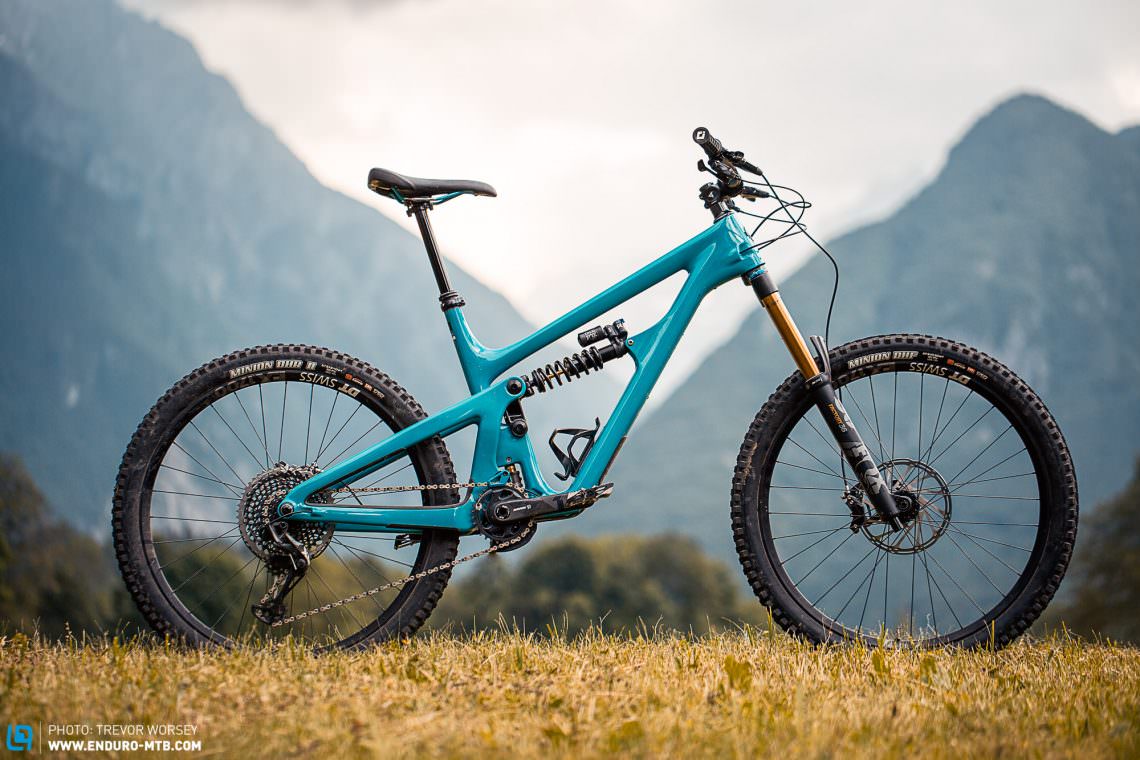
Wheel Size is not the political hotbed it once was, we now have 29ers that are agile and 27.5” bikes that are stable and fast. However, with everyone having a favourite, 29”, 27.5”, or even a combo of both, it’s still challenging for brands to offer choice in their lineups. Yeti has drawn a clear line in the sand with their new strategy, asking us “are you a ripper or a racer?” Ignoring wheel size and suspension travel, Yeti place models into one of two categories based solely on their riding characteristics.
What’s new with the Yeti SB165??
The new 27.5” Yeti SB165 released today is the ‘rip’ rival to the fast and furious ‘race’ 29” Yeti SB150, replacing the popular SB6C, and bringing Yeti’s aggressive geometry to the 27.5” wheelsize. Compared to the SB6C, the seat tube angle has grown radically steeper, while the reach has increased and the head-angle slackened. A new shock extender increases the progression of the suspension kinematic, purpose-designed to work great with a coil shock
The Suspension
It’s no surprise to see that Yeti has incorporated their Switch Infinity platform – unless you have been living under a rock for the last 5 years you will be familiar with Yeti’s unique Switch Infinity translating pivot. Basically, the main pivot is mounted on rails that allow its position to change through the suspension stroke, and as such it allows Yeti’s designers to engineer in different properties at different points of suspension travel. Take for example the anti-squat which peaks at around 110% at SAG, staying flat and stable, but then as the suspension moves beyond around 50% of its travel, the Switch Infinity changes direction and the anti-squat rapidly reduces, decoupling the chain forces from the later parts of the stroke. Yeti have chosen to keep anti-rise consistent at around 95% to preserve the geometry of the bike under hard braking. As the SB165 is a long-travel, big-hit bike, Yeti have optimised it for coil only. As such the SB165 has a much higher progression in the leverage rate (27% compared to 15% of the SB150).
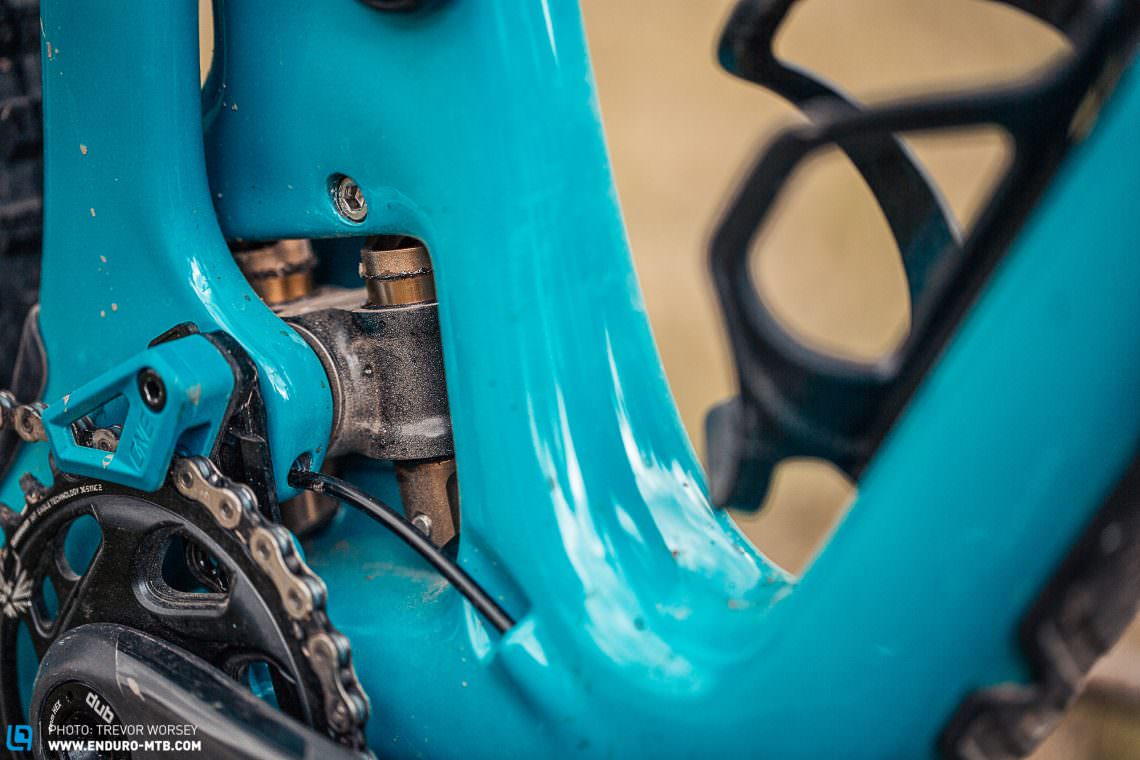
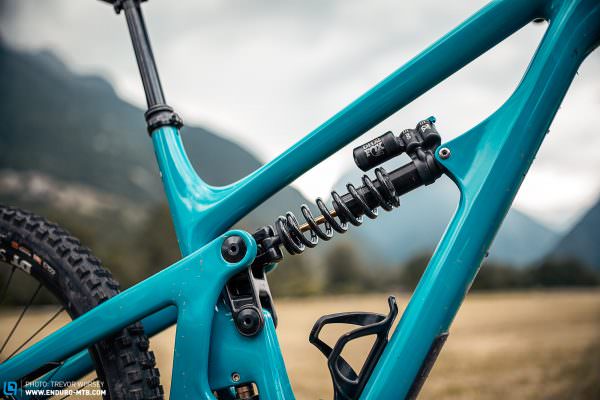
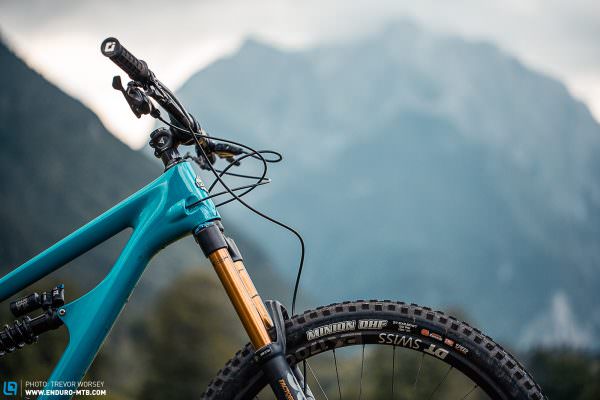

YETI SB165 Specification and models
In the hope of the best reviews, Yeti offered us their TURQ T2 model to test, and at € 8,690.00 we would expect there to be little to dislike in the specification. Suspension is a top-of-the-line Fox affair, with the sublime 180 mm Fox 36 FACTORY GRIP2 fork, backed up by the Fox FACTORY DHX2 coil shock. The Fox treatment continues with a Fox TRANSFER 150 mm dropper post, and the burly cockpit comprises a 800 mm Yeti Carbon bar and Race Face Turbine 50 mm stem. The T2 model rolls on aluminium DT SWISS CUSTOM EX1700 30 mm wheels with Maxxis Minion DHF/DHRII tires front and back with EXO+ sidewalls. SRAM deck out the rest of the build with a full X1/X01 Eagle drivetrain and SRAM CODE RSC brakes with suitably sized 200 / 200 mm rotors.
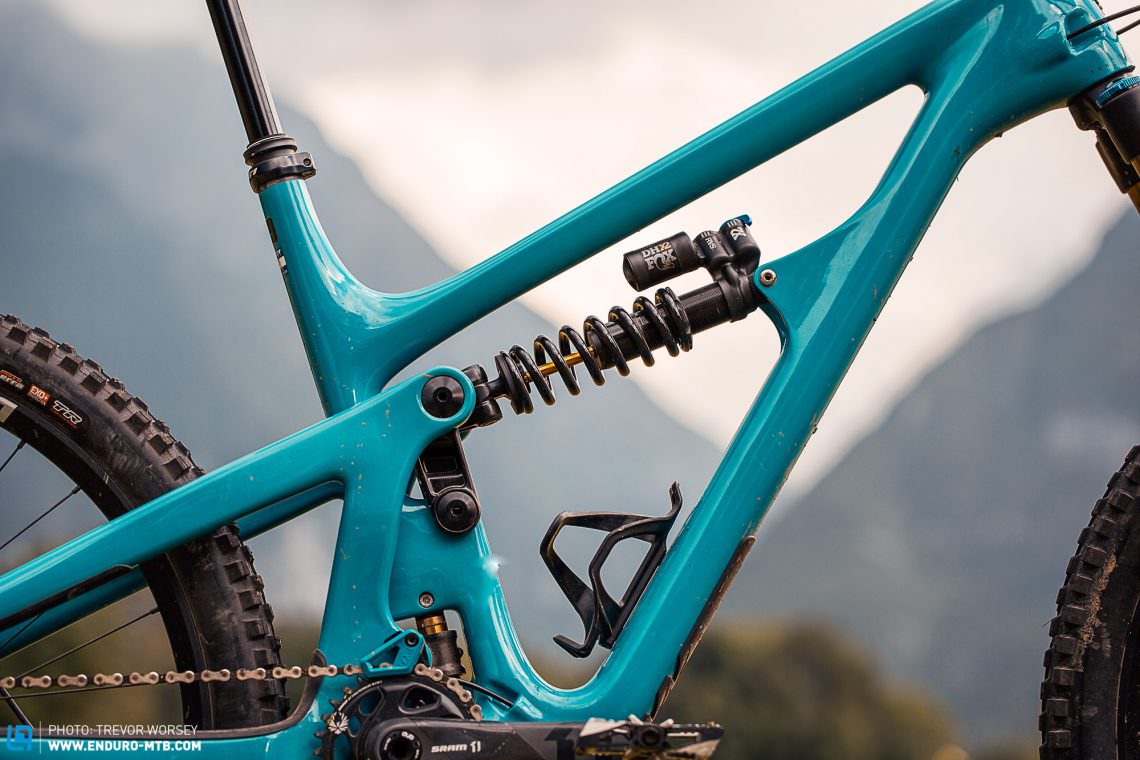
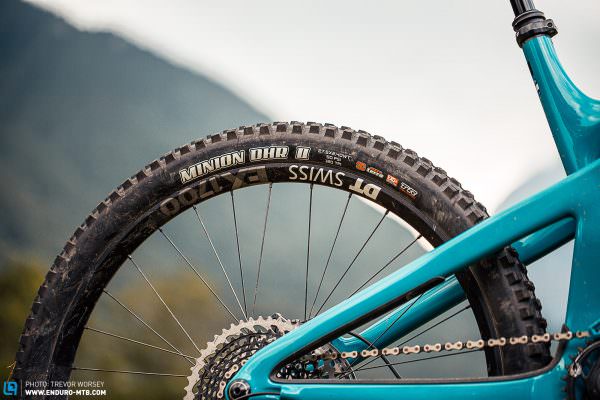

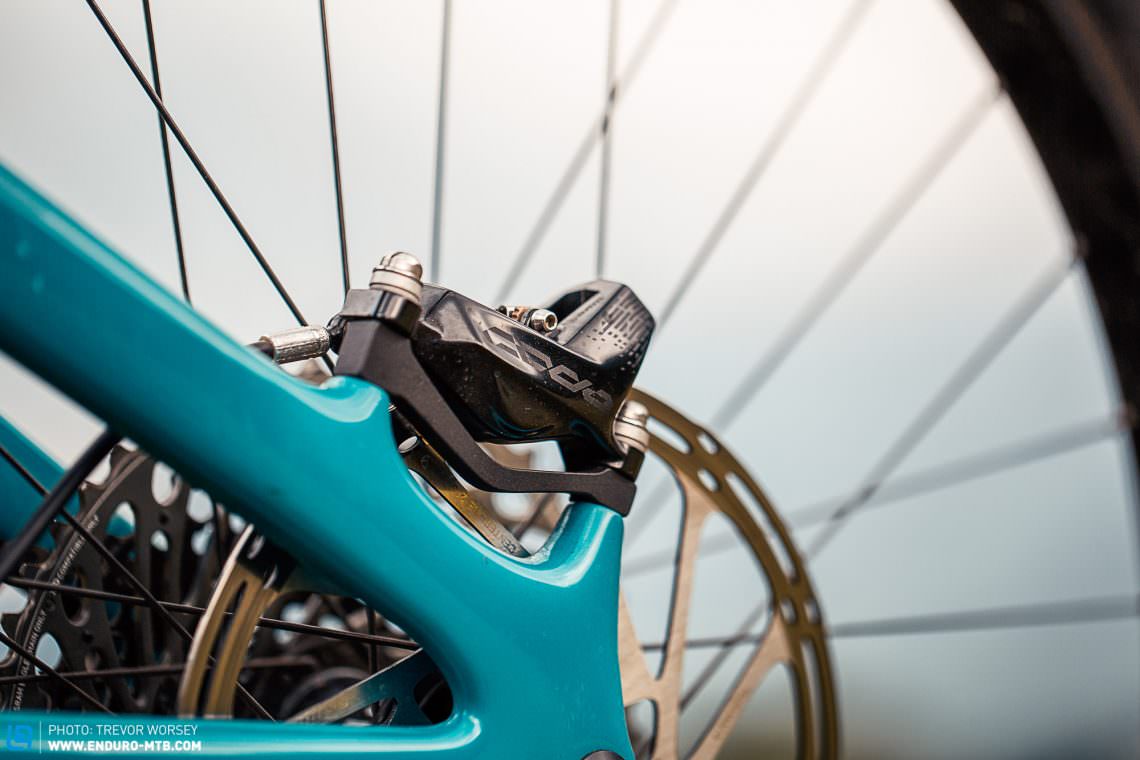
Yeti SB165 T2 TURQ Specification
Fork FOX Factory Grip2 36mm 180 mm
Rear shock FOX Factory DHX2 165 mm
Brakes SRAM CODE RSC 200/200 mm
Drivetrain SRAM XO1 Eagle 1×12
Seat post FOX Transfer 150 mm (L)
Stem Race Face Turbine 35 x 50 mm
Handlebar Yeti Carbon 35 800 mm
Wheels DT Swiss CUSTOM EX1700 27,5″
Tires MAXXIS Minion DHF EXO + 2,5“/ MAXXIS Minion DHRII EXO + 2,4“
The geometry of the Yeti SB165
Yeti are claiming the new SB165 is the ‘Master of the Gnariverse’, and it’s certainly a monster. With 180 / 165 mm travel, and a filthy 63.5-degree head angle, it’s clear that the SB165 is all about getting rowdy. On paper, it’s clearly not just a winch and plummet bike though, and the 77-degree seat angle suggests climbing efficiency. With a reach of 480 mm in large, it sits at the roomier end of the spectrum, while the 433 mm chainstays and 610 mm stack height aim for balance rather than radical numbers. Yeti have chosen a short 37.5 mm fork offset to further stabilise the slack-angled steering. Compared to the outgoing SB6, the SB165 is around 40 mm longer (size large) with a 4 degree steeper seat tube and 1.5-degree slacker head tube – giving it a very different character indeed.
| Size | SM | MD | LG | XL |
|---|---|---|---|---|
| Seat tube | 380 mm | 410 mm | 450 mm | 495 mm |
| Top tube | 567 mm | 599 mm | 622 mm | 649 mm |
| Head tube | 105 mm | 110 mm | 122 mm | 133 mm |
| Head angle | 63.5° | 63.5° | 63.5° | 63.5° |
| Seat angle | 77.0° | 77.0° | 77.0° | 76.9° |
| Chainstay | 433 mm | 433 mm | 433 mm | 433 mm |
| BB Height | 345 mm | 345 mm | 345 mm | 345 mm |
| Wheelbase | 1,198 mm | 1,230 mm | 1,255 mm | 1,285 mm |
| Reach | 430 mm | 460 mm | 480 mm | 505 mm |
| Stack | 595 mm | 600 mm | 610 mm | 620 mm |
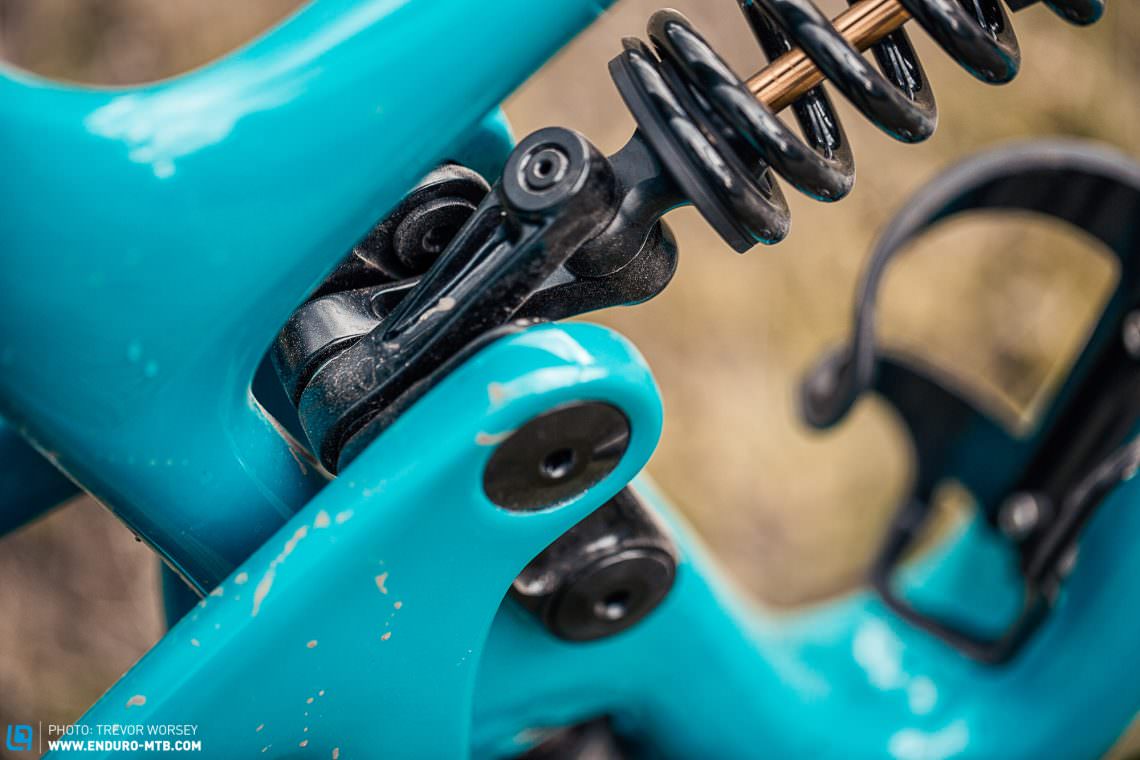
The SB165-Models
As well as the €8690.00 SB165 T2 model as tested, Yeti will also be releasing two other models (in Germany), the affordable SB165 C1 and more Shimano equipped T1. The C series bikes use a heavier carbon fibre layup which is more affordable, while the top-of-the-line T bikes use a higher modulus carbon, resulting in a bike with the same strength, but a lighter construction.
Yeti SB165 C1, Price: € 5,990
The most affordable model in Yeti’s lineup is the €5990.00 C1, which uses a more affordable modulus carbon to reduce the costs – resulting in a small increase in weight. The C1 model features a Fox PERFORMANCE 36 fork and PERFORMANCE VANILLA shock. A full SRAM GX Eagle drivetrain is paired with SRAM CODE R brakes with 200 / 200 mm rotors. The C1 model rolls on DT SWISS E1900 wheels, running Maxxis Minion DHF 2.5 / DHR II 2.4 EXO + tires.
Yeti SB165 T1 TURQ, Price: € 8,190
If you are a Shimano fan, Yeti offer the T1 model with a new 12-speed Shimano XT drivetrain and Shimano XT 4 Piston brakes with 203 / 203 mm rotors. The rest of the specification remains unchanged when compared to the T2 model, with a Fox FACTORY GRIP2 36 fork and FACTORY DHX2 shock and DT SWISS EX1700 wheels with Maxxis Minion DHF/DHRII tires.
Yeti’s New Frame Warranty
Yeti are standing by their bikes and offering a new lifetime warranty on their frames for damage due to manufacturing defects for the original owner. Paint and finish are covered for one year. Also, if you find yourself in a non-warranty situation, Yeti offers a crash replacement policy with a reduced price.
Setting up the Yeti
Fitted with a Fox FACTORY GRIP2 damper and FACTORY DHX2 shock, the myriad of adjustments available from the Yeti SB165 suspension is almost limitless. As such, Yeti have worked hard to ensure that their bikes are as easy to set-up as possible, creating base setup guides that will be available to the end user. To experience the bike with the HSC and LSC settings as Yeti intends, we rode the bike with the recommended setup for an 80 kg rider. The only changes our tester Trev made was to adjust rebound 3 clicks faster to personal preference and set the tires to 22/24 psi. On the trail the base tune felt very good indeed, we did open up the low-speed compression two clicks on the fork for more front-end grip and dialled in two clicks more high-speed compression on the rear shock to deal with the big rock hits we encountered, but that’s it.
Yeti SB165 T2 TURQ review, first impressions
So, what’s the best way to start a test ride on a 180/165 mm big hit beast? By climbing for an hour and a half on a hot day in the Alps, that’s how! Our tester had an extra coffee in anticipation of some freight hauling, but his fears proved unfounded. While not a whippet on the climbs, the new SB165 is not a bad climber at all. The Yeti SB165 has flat-peak of anti-squat around the SAG point which can be felt in the composed suspension, the bike sits high in its travel making the most of the steep 77-degree seat angle – the position is very efficient.

With a low weight of 13.4 kg, you barely notice you’re on a bike with such huge travel reserves. Leaving the two-position compression adjuster on the coil shock in open mode can often be a recipe for a lot of pedal feedback, but the 165 mm Yeti enduro beast stays remarkably composed. Despite such a slack angle at the front, the short offset fork doesn’t hunt around too much and we dispatched the big climbs with minimal fuss, and at trail bike speed.
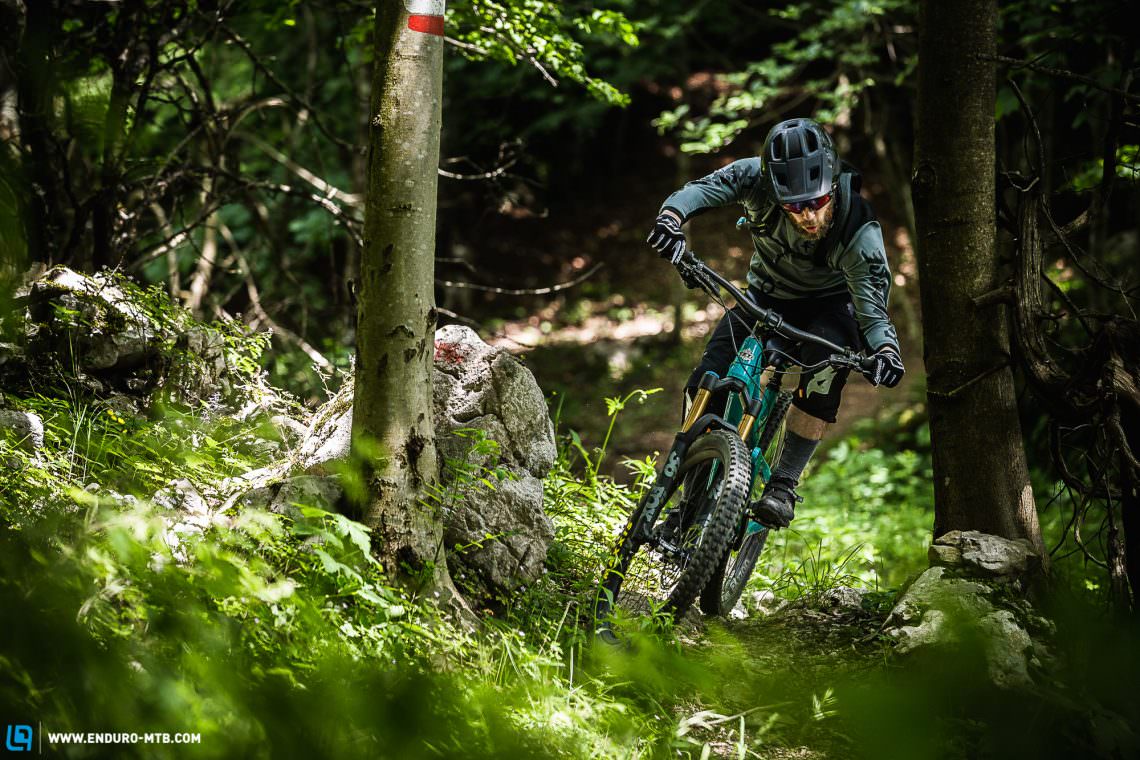
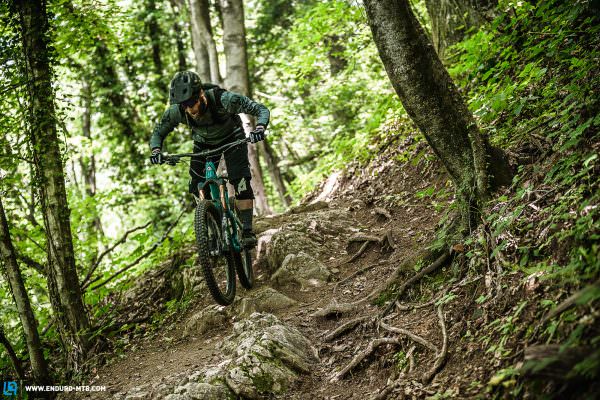

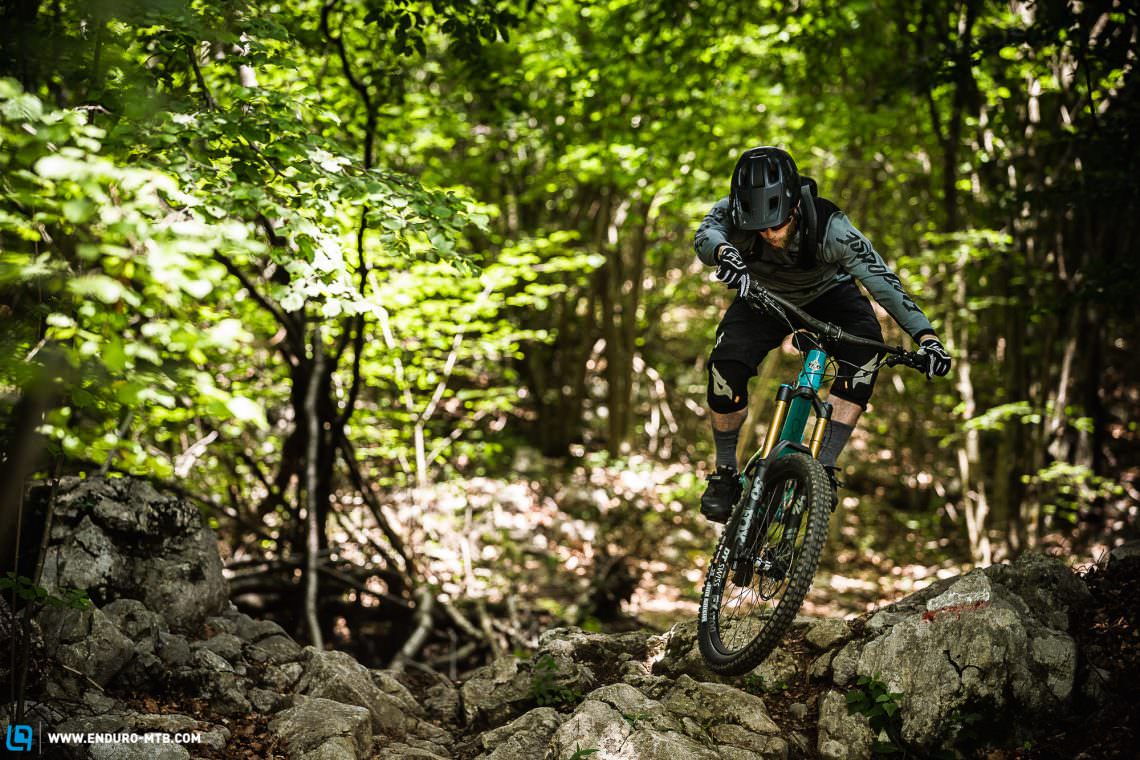
Nobody would call it explosive uphill, but it’s no lazy winch and plummet specialist.
Nobody buys a bike like the Yeti SB165 for the climbs though. Hitting the descent, the SB165 feels the very definition of a rippers bike, the highly progressive suspension gives the bike a poppy feel, while still maintaining predictability, important with the huge reserves of travel. The SB165 loves to jump, the supportive mid-stroke lets you hammer the life out of every take-off, always getting the maximum airtime possible. In the air, the SB165 flies with ease, and when coming back to earth, the long wheelbase and super slack head-angle stabilizes even the most poorly chosen landing. Where the bike does feel great – and uniquely Yeti – is deep in the travel where the translating pivot of the Switch Infinity seems to ‘magic carpet’ over repetitive hits with minimal pedal feedback. There’s no bagginess or wallow to the suspension, a testament to the tune on the Fox Factory DHX2. The components reinforce the burly feeling too, while many will question the lack of carbon wheels at this price point, the DT SWISS EX1700 aluminium rims offer a smooth ride. The SRAM CODE RSC brakes are a team favourite and performed flawlessly during the test, and the X01/X1 Eagle drivetrain gave nothing to complain about. With a stiff frame, great build and composed suspension the Yeti SB165 allows direct lines and rock gardens to be charged at full speed.
The smaller 27.5” wheels do find more holes when charging over rock gardens, but the extra travel helps to pull you through, there’s also no question that the smaller wheels make last-second oh-shit corners easier

In the turns, Yeti has some great D.N.A to work with from the SB series, and for a big bike, it’s surprising how easy you can chuck the back end of the SB165 around underneath you. The smaller wheels give it a lively feel when turning into corners. With a 63.5-degree head angle and short offset fork the steering is never going to be razor-sharp at slow speeds, but ignite the afterburners and everything makes total sense. You have to ride the SB165 with confidence though, weight up front on the bars, if you start death-gripping off the back of the bike the slack angles will see you understeering in the turns.
The Problem with the Yeti SB165
And then we come to the problem. Of course, the Yeti SB165 is a great bike, we would expect nothing less from Yeti, who in all fairness always make great handling bikes. However, the SB165 is niche, and it has an obvious rival. The similarly proportioned ‘race’ 29er SB150 would make a lot more sense for most riders. While the SB150 has 15 mm less travel, the bigger 29” wheels carry speed easier, find fewer holes in rock gardens and the handling is arguably equally as fun. While we understand Yeti’s Rip and Race strategy, we wouldn’t confine the excellent SB150 to racers only, instead, we would say if you love huge air-time and frequently find yourself in lift queues, the SB165 is a total beast for hitting the pro-lines. For everyone else, the bigger wheels of the SB150 will smooth the trails and make everything that much easier, making it a better recommendation for most riders.

Conclusion
Yeti is pitching the SB165 bike as their ‘ripping’ big-hit model, and if your a park rat the Yeti SB165 is an awesome bike. The Switch Infinity suspension offers an excellent blend of support and control, with enough reserves for the biggest hits. If you’re in the market for big Yeti, the only reason not to choose the SB165 is the equally as potent and for most riders more capable SB150
Tops
- Beautiful construction and well-designed hardware
- Suspension balances support with plushness
- Great tune on Fox DHX2 shock
Flops
- The Exo+ tires may look good on the scales, but such a bike needs a tougher sidewall
- The smaller 27.5” wheels do struggle more in holes, most riders would still be better with the SB150
- The high price cannot be ignored
For more information head to yeticycles.com
Did you enjoy this article? If so, we would be stoked if you decide to support us with a monthly contribution. By becoming a supporter of ENDURO, you will help secure a sustainable future for high-quality mountain bike journalism. Click here to learn more.
Words: Photos: Trevor Worsey / Ross Bell









